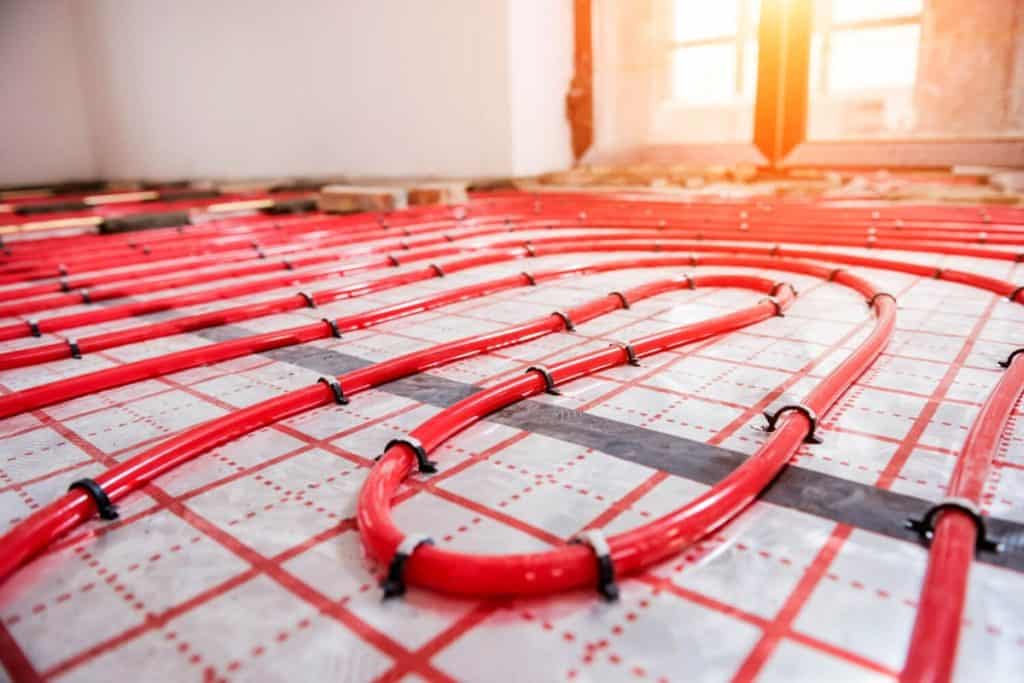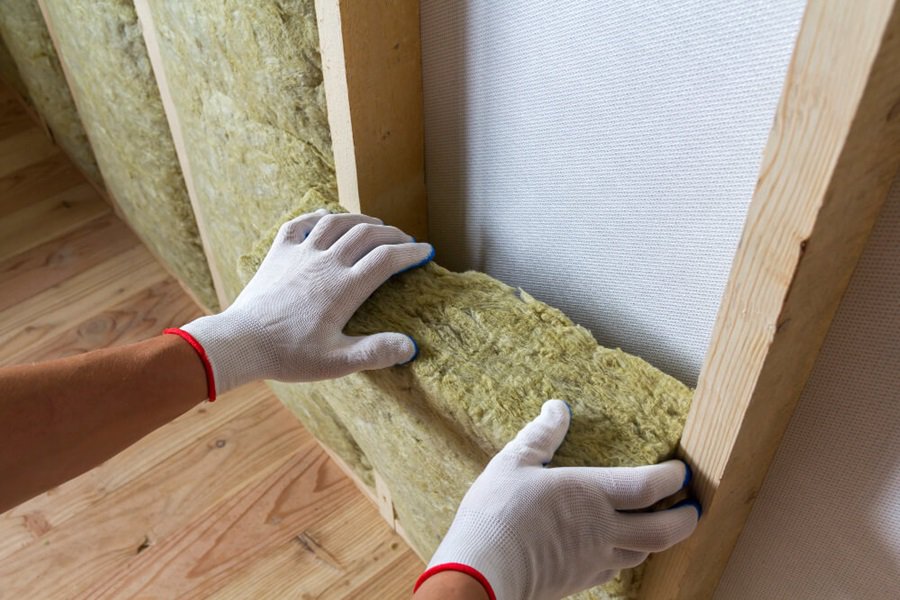
When it comes to the cosy comfort of underfloor heating, there’s more beneath your feet than meets the eye. Have you ever wondered how thick is underfloor heating? In this article, we will look at underfloor heating insulation thickness, explore the various types of underfloor heating systems, and answer any questions that you may have about floor build-ups and height considerations. Understanding how thick is underfloor heating parallels the importance of floor thickness which is key to achieving the perfect underfoot warmth.
Table of Contents
Underfloor heating insulation thickness is a crucial factor in creating a warm and cosy environment in your space. Let’s explore how thick underfloor heating systems should be and how to make the right choice for your project. For context, we will mainly be focusing on electric underfloor heating here.
Understanding Floor Height:
When we talk about floor height in this context, we’re referring to the buildup needed between the substrate (when installing underfloor heating on concrete or timber floors) and the floor finish with what is the best adhesive for underfloor heating (such as porcelain or ceramic tiles, wood, or carpet). Understanding the premise of your floor height will help determine how thick is underfloor heating upon installation.
Selecting the Right Underfloor Heating System:
Whether you opt for water underfloor heating or electric underfloor heating, the heating component itself adds only a minimal thickness to your floor. The real impact on floor height comes from the installation process and the components used in the floor build up. For instance, the thickness of insulation boards or the addition of a decoupling membrane to protect tile or stone floor finishes will influence the overall floor height.
How thick is underfloor heating insulation?
The answer varies depending on your specific preferences. In the following sections, we will look at the finer details, discussing various build-up options and floor height considerations, ensuring you have all the information to make the right choice for your project.
Wet Underfloor Heating:
Wet underfloor heating systems, also known as water or hydronic underfloor heating, are frequently used in new construction or extension projects. Many may wonder here how to install underfloor heating in a conservatory here. These systems offer the advantage of being designed during the early planning stages, which can be integrated seamlessly into the construction process. In wet systems, a network of pipes is embedded using screed. Sometimes, installers need to know how long it takes for screed to dry.
For a quick screed overview, typically, the screed layer should not exceed its recommended depth of 65mm. If you use a flow screed, you can achieve a slightly slimmer screed depth of 40mm. The pipe diameter most commonly used is 16mm, with a recommended pipe run width of 200mm. The thicker, screed-embedded pipework distinguishes wet systems from their electric counterparts. However, this thickness can create challenges when you learn how to retrofit underfloor heating where floor height is a concern.
One drawback of wet underfloor heating in retrofit situations is that it can significantly raise the floor height, often by more than 15cm. Consequently, for existing spaces with limited clearance, electric underfloor heating may be a better choice.
Electric Underfloor Heating:
Electric underfloor heating systems are a thinner and more streamlined alternative to the bulkier water underfloor heating systems, and have less of an impact on the floor height build-up. The diameter of the heating cable can vary depending on the manufacturer and the type of electric system chosen. Some systems feature thinner heating cables, but you should also consider the diameter of the cold tail joint.
Why is this important?
The thickness of the cold tail joint affects the overall floor height as it must be buried beneath the flexible tile adhesive and self levelers during installation. A thicker cold tail joint will require more tile adhesive, resulting in an increased floor build-up. However, a workaround exists—you can create a trench in the insulation layer to accommodate the cold tail joint, though it’s not always the ideal solution.
Electric underfloor heating is ideal for retrofit projects like conservatories, bathroom upgrades, and wet rooms. These systems can be easily fitted onto the existing subfloor without the need for extensive excavation or major adjustments.
Insulation and Its Impact on Thickness:

Another key factor to consider when learning about how thick is underfloor heating is insulation. Besides the heating system itself, insulation plays a vital role in underfloor heating efficiency. It significantly reduces heat loss, ensuring your system operates at its most effective. Choosing the right insulation thickness for your underfloor heating can be integral to how well your underfloor heating will perform.
For electric systems, our insulation boards are available in various thicknesses, ranging from 6mm to 50mm. This allows you to select insulation that won’t excessively raise your floor level. In the case of water-based systems, insulation panels are often incorporated or provided separately. Be sure to visit our kit builder page to see how you can build your own underfloor heating kit.
Flooring Heights in New-Build Projects:
In new-build projects, it is a lot easier to install underfloor heating than in an existing or period properties. You have the advantage of factoring in the dimensions of your chosen heating system during the planning stage, allowing you to calculate ceiling heights in relation to floor heating thickness. This means you won’t need to worry about the impact of your heating system on the overall flooring build-up.
Water underfloor heating types are usually recommended for new-builds. Many of these systems require a layer of concrete screed to work efficiently alongside the heating components. This may not be suitable for renovation projects due to the necessary depths involved, so make sure to consider this when learning how thick is underfloor heating.
Reducing Height Build-Up
As you consider minimising the height of your flooring build-up, it may be tempting to consider removing the insulation board, but this can have greater consequences for homeowners.
Here’s why:
Imagine a beautifully tiled floor with the substrate below, the heating cable, and flexible tile adhesive, all topped with stunning tiles. When you install underfloor heating without an insulation board, the heating cable will not only warm the layer below, but it will also heat the layer above at the same rate. As a result, it will take significantly longer for the floor to reach the desired temperature, and this extended heating time translates to higher energy costs.
However, when you include insulation boards in the floor build-up, you drastically reduce heat loss downward toward the substrate. Instead, the majority of the heat efficiently warms the floor above. This means your underfloor heating system will require less time to reach the optimum temperature, ultimately saving you money on overall running costs. Be sure to consider insulation boards when measuring how thick is underfloor heating.
Benefits of Using Insulation Boards for Underfloor Heating
There are a number of benefits of using insulation boards for your methods on how thick is underfloor heating. Such benefits include:
- Strength: Insulation board adds structural integrity to your floor build-up, ensuring a durable and long-lasting result.
- Reduced Noise: It also aids in reducing impact sound, contributing to a quieter and more comfortable living space.
- Lightweight: Insulation boards are incredibly lightweight, so they won’t strain your floor design or pose any unnecessary burdens.
When considering insulation boards, we generally recommend a minimum thickness of around 10mm, which aligns with the industry standard.
Choosing the Right Insulation Board:
Two main types of insulation boards are worth considering: uncoated and coated.
- Low Profile Insulation Boards: These low profile insulation boards provide cost-effective thermal insulation for concrete and screed substrates. They are crafted from high-density extruded polystyrene and can be seamlessly installed using a flexible cement-based tile adhesive. These are available in 6mm and 10mm.
- Gypsum Screed Boards: Our Gypsum Screed boards have a high-density extruded polystyrene core with a fibreglass-reinforced cement coating on both sides. This coating adds rigidity and strength, making them ideal for timber substrates. These boards are also water-resistant and rot-proof, making them an excellent choice for wet environments like bathrooms and wet rooms.
Incorporating insulation boards into your floor build-up not only optimises the performance of your underfloor heating system but also adds valuable benefits like structural support and noise reduction, therefore proving that it is worth knowing about how thick is underfloor heating.
Understanding How Thick Is Underfloor Heating For Installation
In conclusion, to understand how thick is underfloor heating is essential for creating a comfortable and efficient heating system in your space. We explored the differences between wet and electric underfloor heating systems, their impact on floor height, and the critical role of insulation boards in optimising performance. Ultimately, the right choice depends on your specific needs and project requirements, ensuring that warmth and comfort always meet your expectations in your underfloor heating projects. Additionally, knowing when to switch your underfloor heating off to save money will depend on the time of year.
FAQs
How thick is underfloor heating overlay?
Underfloor heating overlay systems, designed to be installed on top of existing floors, are typically thin to minimise the increase in floor height. These overlay systems can vary in thickness, but they generally range from 12mm to 30mm. The exact thickness will depend on the specific product and manufacturer.
Is 25mm insulation enough for underfloor heating?
A 25mm insulation layer can be used for underfloor heating, especially in overlay systems where minimal height addition is desired. However, the effectiveness of this thickness will depend on the type of insulation material, the existing floor structure, and the specific heating requirements. While 25mm insulation can be suitable for some scenarios, thicker insulation might be recommended for areas with higher heat loss or in cases where optimal energy efficiency is desired.
How thick should underfloor heating insulation be?
The recommended thickness for underfloor heating insulation varies based on the type of building, its location, the floor structure, and the desired energy efficiency. In general, insulation thicknesses of 50mm to 100mm are common for new builds or major renovations. However, for retrofit scenarios or overlay systems, thinner insulation layers, like 25mm to 50mm, might be used. It’s essential to consult with an underfloor heating specialist to determine the optimal insulation thickness for a specific project.
Can you put underfloor heating straight onto concrete?
Yes, underfloor heating can be installed directly onto a concrete subfloor. However, it’s crucial to ensure that:
The concrete is dry and free of any moisture issues.
An insulation layer is placed between the concrete and the heating system to prevent heat loss downwards and to ensure efficient upward heat distribution. This insulation can be in the form of boards or a screed layer with integrated insulation properties.
The concrete subfloor is level and free of debris.
Direct installation onto concrete without proper insulation can lead to reduced efficiency, longer warm-up times, and increased energy costs.
Sources
Tambini, N., (2023) Is underfloor heating expensive and should I turn it off to save money? Metro. [online] Available at: https://metro.co.uk/2023/02/11/is-underfloor-heating-expensive-should-i-turn-it-off-to-save-money-18262420/ [accessed 16/10/23]
